Understanding the Synergy of ABA and Peer-Mediated Approaches
Applied Behavior Analysis (ABA) stands as a cornerstone in the treatment of autism spectrum disorder (ASD), with a strong evidence base supporting its effectiveness in teaching critical skills. Among the evolving strategies to enrich ABA therapy, peer-mediated interventions (PMI) have emerged as promising tools to enhance socialization and communication. This article explores ABA therapy's foundations, the integration of PMI within ABA frameworks, and how this combination amplifies developmental outcomes for children with ASD.
What is Applied Behavior Analysis (ABA) Therapy?

What is Applied Behavior Analysis (ABA) therapy?
Applied Behavior Analysis (ABA) therapy is a scientific and systematic approach used to enhance socially important behaviors, most notably in children with autism spectrum disorder (ASD). It focuses on identifying environmental influences that affect behavior and utilizes behavioral principles to encourage positive change. This therapy dissects behaviors by examining their triggers and outcomes, enabling practitioners to develop effective reinforcement strategies.
How is ABA scientifically grounded and individualized?
ABA is grounded in behavioral science, relying on evidence-based methods to analyze and modify behavior. Each ABA program is tailored to the individual’s unique needs, created by professionals like Board Certified Behavior Analysts (BCBAs). This personalized design ensures interventions specifically target skills that are most relevant to improving the child’s communication, social interaction, and daily living abilities.
What are common ABA techniques?
Several well-established techniques are employed within ABA therapy, including:
- Discrete Trial Training (DTT): Structured teaching focusing on one skill at a time with clear instructions and reinforcement.
- Early Start Denver Model (ESDM): A naturalistic approach combining play, communication, and social skills designed for young children.
- Picture Exchange Communication System (PECS): Using pictures to help children communicate their needs and desires.
- Pivotal Response Treatment (PRT): Targeting pivotal areas of development like motivation and self-management.
Each method emphasizes positive reinforcement to encourage desirable behaviors.
In what settings is ABA therapy delivered?
ABA therapy is versatile in its delivery environments, with sessions commonly conducted in:
- Home settings: Allowing focus on everyday contexts.
- School environments: Supporting academic and social development.
- Community settings: Providing opportunities for generalization of skills.
- Hospital-rehabilitation centers: Specialized locations for controlled intervention.
This adaptability helps integrate learned behaviors across different areas of a child’s life.
Collectively, ABA therapy stands as an evidence-based treatment option that, when applied intensively and consistently, has been shown to improve communication, social skills, and functional behaviors in children with ASD.
How ABA Therapy Supports Individuals with Autism

What is Behavioral Support via ABA?
Applied Behavior Analysis (ABA) is a scientific approach that identifies environmental factors influencing behavior. It uses systematic methods to teach and reinforce positive behaviors while reducing challenging ones. This approach is customized to each child, making interventions more effective.
How Does ABA Improve Communication and Social Skills?
ABA-based interventions like the Early Start Denver Model (ESDM) and Peer-Mediated Intervention (PMI) focus heavily on enhancing communication and social interactions. PMI, for example, trains typically developing peers to engage children with autism, boosting social motivation and interaction. These methods utilize social games that encourage imitation, sharing, and social initiation.
How Are Daily Living Skills Developed?
ABA therapy also targets daily living and self-help skills, helping children with autism gain independence. Through consistent practice and reinforcement, children learn essential tasks that improve their ability to manage everyday routines.
What Does Individualized Intervention Planning Involve?
Each ABA program starts with detailed assessments to create personalized treatment plans tailored to the unique needs of the child. Interventions may include Discrete Trial Training (DTT) and Picture Exchange Communication System (PECS), focusing on specific developmental domains such as language or adaptive behavior.
What Are the Outcomes of Early Intensive ABA?
Early and comprehensive ABA treatments have shown promising results, particularly in improving socialization, communication, and expressive language. Meta-analyses indicate significant gains in these areas, although effects on overall autism symptoms or cognition may require further study. Long-term ABA also supports intellectual functioning and social skills development.
ABA therapy empowers caregivers and educators with tools and strategies for ongoing support, fostering growth across multiple areas of development and helping individuals with ASD reach their full potential.
Who Provides ABA Therapy and Their Qualifications

Who Provides ABA Therapy and What Qualifications Do They Typically Have?
Applied Behavior Analysis (ABA) therapy is delivered by a team of trained professionals specialized in behavior analysis. The main providers include Board Certified Behavior Analysts (BCBAs), Board Certified Assistant Behavior Analysts (BCaBAs), and Registered Behavior Technicians (RBTs). Each of these roles plays a distinct part in implementing ABA interventions for children with autism spectrum disorder (ASD).
Key ABA Professionals and Their Roles
Board Certified Behavior Analysts (BCBAs): BCBAs are master's level practitioners who design, oversee, and evaluate ABA intervention programs. They conduct assessments, develop individualized treatment plans, and provide supervision to other ABA practitioners.
Board Certified Assistant Behavior Analysts (BCaBAs): BCaBAs hold bachelor's or master's degrees and work under the supervision of BCBAs. They assist with program implementation, data collection, and carry out behavioral interventions.
Registered Behavior Technicians (RBTs): RBTs are frontline therapists who implement ABA interventions directly with clients. They typically require a high school diploma or equivalent and complete specialized training before certification, operating under BCBA supervision.
Certifications and Training
To become a BCBA, candidates generally need a master's degree in behavior analysis or a related field, complete specific supervised fieldwork hours, and pass the Behavior Analyst Certification Board (BACB) examination. BCaBAs and RBTs also undergo formal training and certification processes, though these are less extensive than those required for BCBAs. This tiered certification structure ensures that all intervention delivery personnel are properly qualified according to their responsibilities.
Importance of Supervision and Ethical Standards
Supervision by BCBAs is vital in maintaining the quality and integrity of ABA therapy. It ensures that interventions are implemented consistently and according to evidence-based guidelines. Ethical standards, as outlined by the BACB, govern professional conduct to protect clients and promote effective treatment. Adhering to these standards includes respecting client dignity, ensuring data accuracy, and following best practices for intervention.
In summary, ABA therapy providers range from highly trained BCBAs to RBTs who implement interventions directly, all working within a structured certification and supervision framework to maximize treatment effectiveness and uphold ethical care.
Common Techniques Used in ABA Therapy

What are common techniques used in ABA therapy?
Applied Behavior Analysis (ABA) therapy incorporates a variety of techniques tailored to support skill development and behavioral improvement in children with autism spectrum disorder (ASD). Here are some commonly used strategies:
Positive Reinforcement: This technique encourages desired behaviors by rewarding them. For example, when a child communicates effectively, they may receive praise or a favorite activity, strengthening the likelihood of repeating that behavior.
Prompting and Fading: These steps assist individuals in performing tasks initially with some help (prompting) and gradually reduce the assistance as the child gains independence (fading). This ensures the skill is learned and retained.
Discrete Trial Training (DTT): DTT is a highly structured learning method where skills are broken down into small steps and taught in short, repeated trials. This approach helps focus learning and measure progress clearly.
Behavior Chaining: Complex behaviors are divided into smaller, teachable units. Children learn each step sequentially until the entire behavior (such as handwashing) is mastered.
Modeling and Visual Aids: Children learn by imitating others. Visual supports like pictures, videos, or demonstrations show the desired behavior, helping children understand and replicate it.
Natural Environment Teaching (NET): Learning is embedded in everyday situations, making skills more generalizable and meaningful. For instance, teaching communication during playtime or snack time.
Behavior Reduction Techniques: ABA also focuses on reducing challenging or undesired behaviors. Techniques include extinction (ignoring inappropriate behaviors to decrease them), redirection to appropriate actions, and teaching alternative behaviors.
Picture Exchange Communication System (PECS) and Visual Supports: PECS uses pictures to help children communicate their needs and desires, which is especially helpful for nonverbal children or those with limited speech.
These techniques work together within ABA to target improvements across communication, social interaction, daily living, and self-help skills, supporting children with ASD to reach their full potential.
Overview of ABA-Based Interventions in Autism
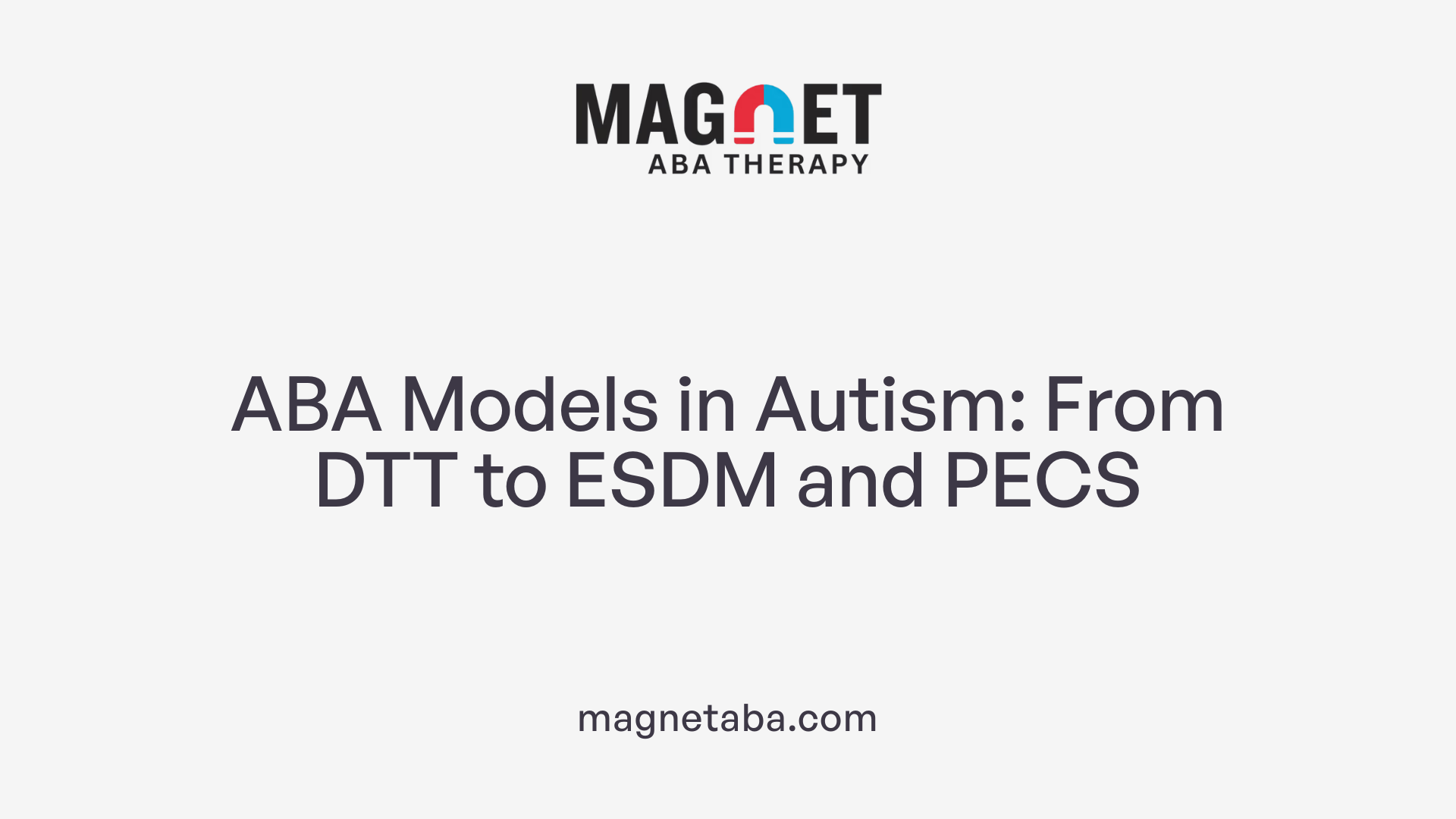
What Are Various ABA-Based Models?
Applied Behavior Analysis (ABA) encompasses several intervention methods that address the diverse needs of children with autism spectrum disorder (ASD). Notable ABA-based models include Early Start Denver Model (ESDM), Picture Exchange Communication System (PECS), and Discrete Trial Training (DTT).
What Is the Early Start Denver Model (ESDM)?
ESDM is an early intensive behavioral intervention targeting young children with ASD. It integrates ABA principles with developmental and relationship-based approaches to promote communication, social skills, and cognitive abilities in a naturalistic setting.
What Is the Picture Exchange Communication System (PECS)?
PECS is a communication aid that uses pictures to help nonverbal or minimally verbal children with ASD initiate communication. By exchanging pictures, children learn to express needs, desires, and ideas, fostering expressive language development.
What Is Discrete Trial Training (DTT)?
DTT breaks down skills into small, structured teaching trials. Each trial involves a clear instruction, child response, and consequence, systematically reinforcing desired behaviors. It is effective for teaching basic skills such as language, social interaction, and daily living tasks.
Which Developmental Domains Do These Interventions Target?
ABA-based interventions focus on critical developmental domains including:
- Communication (both expressive and receptive)
- Social interaction and skills
- Daily living and self-help skills
- Cognitive functions
What Is the Evidence Supporting These Interventions?
A meta-analysis of 14 randomized controlled trials involving 555 participants highlighted promising outcomes in socialization, communication, and expressive language following ABA-based interventions. However, no significant improvements were noted in broader autism symptoms, receptive language, or adaptive behaviors, likely due to fewer studies in these areas.
Long-term, comprehensive ABA programs have demonstrated potential for enhancing intellectual functioning, language development, daily living skills, and social functioning. This evidence supports the role of ABA and its models like ESDM, PECS, and DTT as effective approaches for individualized treatment plans in children with ASD.
Measuring the Impact of ABA: Outcomes and Meta-Analyses

What do meta-analyses reveal about ABA therapy outcomes?
A comprehensive meta-analysis reviewing 14 randomized controlled trials involving 555 children with autism spectrum disorder (ASD) showed promising effects of ABA-based interventions in specific developmental domains. The data highlighted significant improvements in socialization, communication, and expressive language after ABA treatment, underscoring the approach's effectiveness in enhancing these core skills.
Which areas show improvement through ABA?
ABA interventions consistently target and improve:
- Socialization: Enhanced ability to interact and engage with others.
- Communication: Better verbal and nonverbal communication capabilities.
- Expressive language: Increased ability to express thoughts and needs verbally.
These positive results point to ABA's strength in developing interpersonal and communicative skills critical for children with ASD.
Are there areas where ABA shows no significant impact?
The meta-analysis found no significant improvements in several other domains, including:
- Autism general symptoms
- Receptive language
- Adaptive behavior
- Daily living skills
- IQ (both verbal and nonverbal)
- Restricted or repetitive behaviors
- Motor skills
- Cognition
This lack of measurable change may reflect insufficient research or variability in study designs, rather than ineffectiveness of ABA in these areas.
What limitations affect the interpretation of ABA study outcomes?
One important limitation stems from the relatively few available studies assessing certain outcomes. The limited sample sizes and diversity of methods mean some potential benefits of ABA could be underrepresented or difficult to detect consistently.
What are the benefits of long-term, comprehensive ABA interventions?
Extended, intensive ABA treatments have been linked to broader gains over time, including:
- Improved intellectual functioning
- Enhanced language development
- Greater daily living skills
- Better social functioning
Such long-term interventions may help foster sustained developmental progress beyond initial therapy periods.
| Outcome Domain | Impact of ABA | Notes |
|---|---|---|
| Socialization | Significant improvement | Enhanced social skills and interaction |
| Communication | Significant improvement | Better verbal and nonverbal communication |
| Expressive Language | Significant improvement | Improved ability to express oneself |
| Autism Symptoms | No significant change | May require additional specialized methods |
| Receptive Language | No significant change | Limited research available |
| Adaptive Behavior | No significant change | Variability in outcomes reported |
| Daily Living Skills | No significant change | Improved with long-term interventions |
| IQ and Cognition | No significant change | More research needed to clarify impacts |
These findings guide clinicians and families in understanding where ABA is most effective and highlight areas needing further study.
Introducing Peer-Mediated Intervention (PMI) in ABA

What is Peer-Mediated Intervention (PMI)?
Peer-Mediated Intervention (PMI) is a collaborative approach within Applied Behavior Analysis (ABA) that involves teaching typically developing peers to actively engage children with Autism Spectrum Disorder (ASD) in social interactions. These peers are carefully selected based on strong social and academic skills and receive specific training to encourage positive social behaviors. PMI moves beyond traditional one-on-one therapy by leveraging natural peer relationships as a platform for social skill development.
How Are Peers Involved in PMI?
In PMI, trained peers serve as social models and facilitators, guiding children with ASD through structured social games and activities that promote communication, imitation, and initiation of interaction. Examples of such games include imitation games and rotating passing games designed to build social motivation and enhance engagement. This peer involvement creates an inclusive environment where social learning occurs naturally and repeatedly throughout the day.
What Are the Goals of PMI for Children with ASD?
The primary aim of PMI is to improve social skills among children with ASD. This includes increasing social motivation, fostering communication, reducing undesired behaviors, and enhancing reciprocal social interactions. Studies using validated tools like the Social Responsiveness Scale (SRS) demonstrate significant gains, especially in children with mild to moderate ASD symptoms, highlighting PMI’s effectiveness in addressing social communication challenges.
How is PMI Integrated Within ABA Therapy?
PMI is often integrated as part of early intensive behavioral interventions (EIBI) under the broader ABA framework. Rather than replacing one-on-one ABA sessions, PMI complements them by providing peer-mediated social learning opportunities, often implemented in settings such as hospital rehabilitation centers or classrooms. Training procedures for peers and facilitators focus on ensuring intervention fidelity, thus maximizing the positive impacts on social functioning.
| Aspect | Description | Purpose/Outcome |
|---|---|---|
| Peer Selection | Peers chosen for strong social and academic skills | To model and reinforce positive social behaviors |
| Training | Thorough preparation of peers and facilitators | Ensure consistency and effectiveness of interventions |
| Social Games | Activities like imitation and passing games | Encourage communication, imitation, and initiation of interactions |
| Target Skills | Social motivation, communication, social interaction | Improve social functioning and reduce undesirable behaviors |
| Implementation Sites | Hospital rehabilitation, classrooms, inclusive settings | Provide diverse contexts for social learning |
Through this integration, PMI exemplifies an innovative extension of ABA principles designed to harness peer influence for enhancing social competency in children with ASD.
The Effectiveness of PMI: Evidence from Randomized Controlled Trials

What do randomized controlled trials reveal about the effectiveness of PMI?
Peer-mediated intervention (PMI) has been rigorously tested in well-conducted randomized controlled trials (RCTs) demonstrating its effectiveness for children with autism spectrum disorder (ASD). These trials involved teaching typically developing peers to engage children with ASD in structured social interactions and play activities.
How does PMI compare to traditional ABA-based therapy?
In one notable RCT, children receiving PMI showed significantly greater improvements in overall social skills and social communication compared to those undergoing traditional ABA-based therapy. This highlights PMI’s potential advantage over some conventional individual-focused ABA treatments, particularly for enhancing peer-related social engagement.
Which measurement instruments are used to evaluate PMI outcomes?
Validated scales like the Social Responsiveness Scale (SRS) and the Child Autism Rating Scale (CARS) are employed to assess symptom severity and social behaviors pre- and post-intervention. These robust tools help provide quantitative evidence for PMI’s impact on social skills development.
What findings have been observed regarding social skills and communication?
The trials found PMI leads to increased social motivation, reduced undesirable behaviors, and enhanced social interactions, particularly in children with mild to moderate ASD symptoms. Improvements were noted in key areas such as social communication, initiation of interaction, and peer engagement.
By training peers in social games involving imitation and turn-taking, PMI fosters naturalistic social learning conditions. The hospital-rehabilitation settings of these studies provide a controlled environment ensuring intervention fidelity and consistent training of peers. Overall, randomized controlled trials support PMI as an effective, evidence-based approach for improving social skills and communication in children with ASD, offering a valuable complement or alternative to traditional ABA therapies focused primarily on adult-directed intervention.
How PMI Enhances Social Motivation and Interaction

Increased Social Motivation
Peer-mediated intervention (PMI) has been shown to significantly boost social motivation among children with autism spectrum disorder (ASD). By involving typically developing peers as active social partners, children with ASD receive natural encouragement to engage in social behaviors. This peer involvement fosters a more engaging and motivating environment, encouraging children to initiate and respond to social interactions more frequently.
Reduced Undesirable Behaviors
PMI also contributes to a reduction in undesirable behaviors. With increased social engagement opportunities and structured interaction through social games, children with ASD tend to display fewer problematic behaviors. The interaction with peers provides positive reinforcement and prompts appropriate social responses, which can replace less adaptive behaviors.
Enhancement of Social Interaction Skills
The structured design of PMI sessions, such as imitation games and rotating passing games, directly targets the development of important social interaction skills. Children learn to initiate communication, imitate peers, and sustain social exchanges. These activities are carefully guided and monitored to ensure meaningful social learning, leading to improvements in social communication and broad social skills.
Especially Effective in Mild to Moderate ASD
Research indicates that PMI is particularly beneficial for children with mild to moderate ASD symptoms. These children tend to gain the most from peer-led social interventions, showing greater improvements in overall social skills and social communication scores compared to traditional ABA-based therapies. The naturalistic setting of PMI and the use of trained peers create an inclusive environment that helps maximize social developmental gains.
Overall, PMI offers a promising approach by leveraging peer interactions to motivate children with ASD socially, reduce problematic behaviors, and enhance their social skills, thus supporting better developmental outcomes in mild to moderate cases.
Settings of Peer-Mediated Interventions: Beyond Classrooms

What Are Hospital-Rehabilitation Settings for Peer-Mediated Interventions?
Hospital-rehabilitation settings provide structured environments outside of traditional schools where children with ASD can engage in specialized therapies. Peer-Mediated Intervention (PMI) in these settings involves typically developing peers participating in carefully designed social games, such as imitation or rotating passing games. This approach leverages peer interaction to foster social skills like communication, imitation, and social initiation.
What Are the Benefits of Alternative Settings?
Using hospital-rehabilitation settings offers several advantages:
- Controlled environment: Therapists and trained peers can closely monitor and support each child's progress, ensuring intervention fidelity.
- Tailored interventions: These settings allow for personalized, consistent sessions that may be difficult to achieve in busier school environments.
- Focus on early skill development: The settings emphasize foundational social skills before integration into more complex social contexts.
- Access to expert supervision: Rehabilitation centers have professionals specialized in behavioral therapy and autism, enhancing intervention quality.
How Do These Settings Differ from School-Based or Inclusive Environments?
Unlike school-based interventions, hospital-rehabilitation settings emphasize intensive, individualized peer interaction outside the usual classroom distractions. Schools offer naturalistic social interactions but can be unpredictable and less controlled for therapeutic goals. Inclusive environments promote integration with typically developing peers but may lack the structured support and training that hospital settings provide, such as careful peer selection and thorough training for social engagement. Thus, hospital-rehabilitation PMI serves as a complementary step, focusing on building essential social competencies that can later be generalized within school and community settings.
Manualized Social Games in PMI: Imitation and Rotating Passing Games
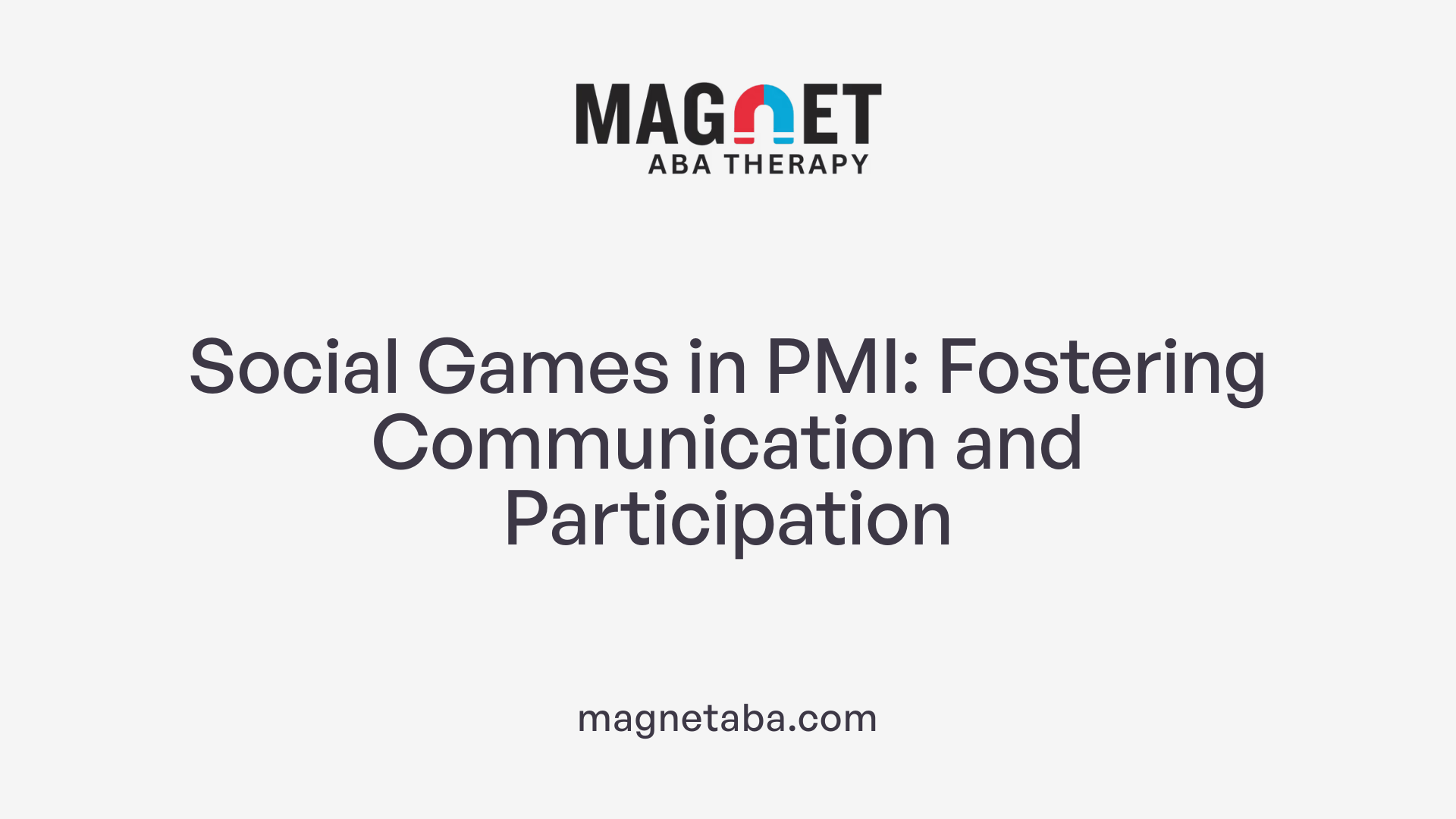
What Are the Social Games Used in PMI?
Peer-Mediated Intervention (PMI) involves structured social games that aim to foster social skills in children with autism spectrum disorder (ASD). Two specific games frequently used are imitation games and rotating passing games. These structured activities are manualized, meaning they follow a fixed format to ensure consistent application during therapy sessions.
How Does Imitative Play Work?
Imitation games focus on encouraging children with ASD to copy the actions or behaviors of their peers. This type of play leverages natural social learning by promoting observation and replication. Through imitation, children practice essential social behaviors such as turn-taking, eye contact, and shared attention, laying a foundation for more complex social exchanges.
What Are Rotating Passing Games?
Rotating passing games involve children passing objects in a specific sequence during group play. This activity creates opportunities for social initiation and communication as each child must interact with others to keep the game moving. The rotation aspect encourages inclusion and sharing, helping children practice social reciprocity and cooperation in a supportive setting.
Why Do These Games Encourage Communication and Social Initiation?
Both imitation and rotating passing games are intentionally designed to increase social motivation by engaging children in enjoyable, interactive activities. They provide clear prompts for children to use communication skills such as requesting, responding, and initiating social interactions. By embedding these social demands within playful scenarios, PMI creates natural occasions where children can practice and develop their communication and social skills in a meaningful context.
These manualized social games not only support children with ASD to improve social responsiveness but also help peers understand how to interact effectively, reinforcing positive social behaviors. Through systematic training and a structured approach, these games maximize the potential for social learning within PMI, especially in early developmental stages.
| Social Game Type | Description | Social Skills Targeted |
|---|---|---|
| Imitation Games | Children copy peers' actions and behaviors | Turn-taking, attention, social referencing |
| Rotating Passing Games | Children pass objects sequentially | Communication initiation, sharing, cooperation |
Training Peers and Experimenters for Effective PMI
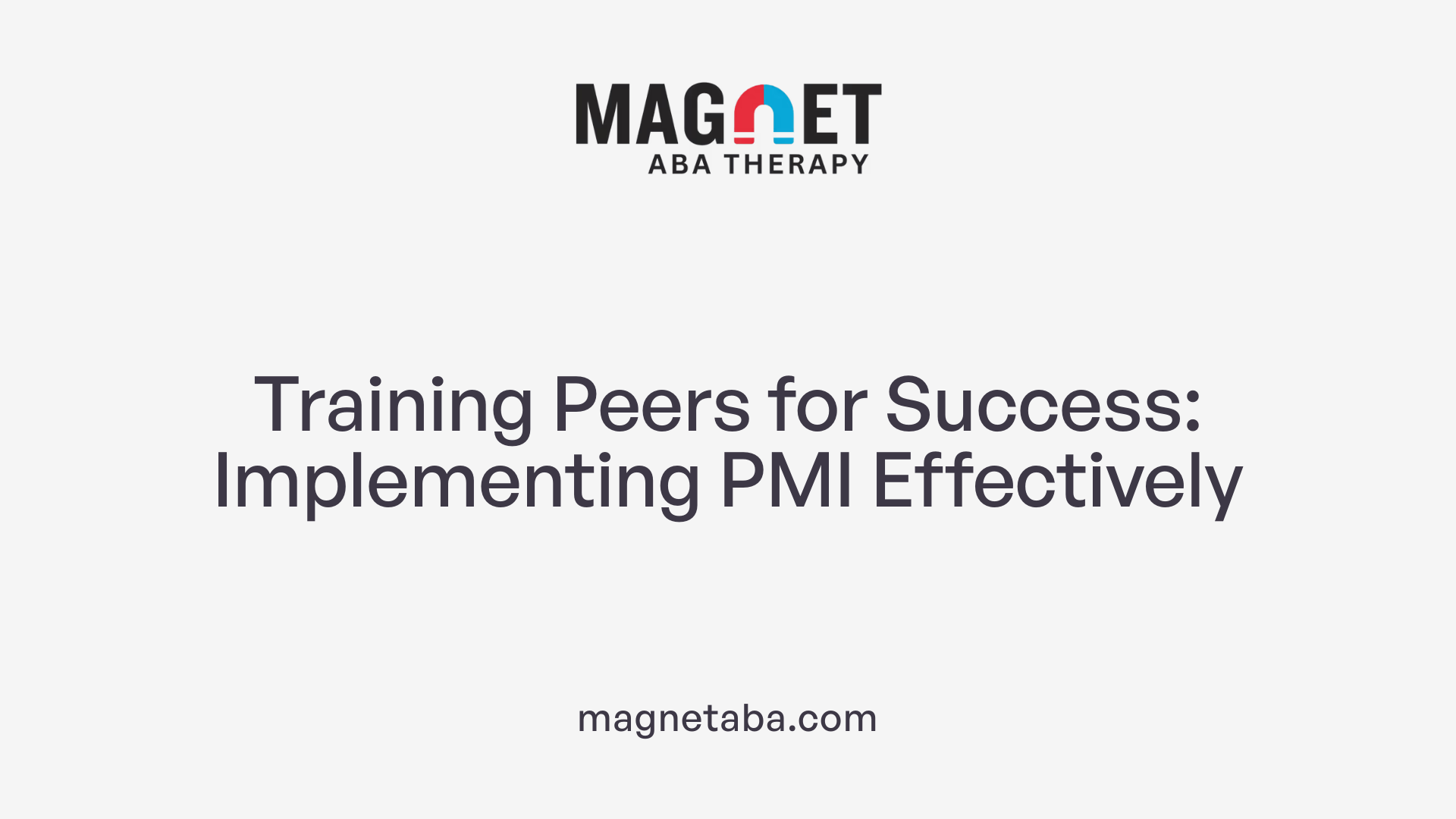
Importance of Thorough Training
Thorough training of peers and experimenters is essential to the success of peer-mediated interventions (PMI) in supporting children with autism spectrum disorder (ASD). Comprehensive preparation ensures that participants understand intervention goals and techniques, which directly influences the quality and consistency of the social interactions facilitated during the intervention.
Peer Selection Criteria
Careful peer selection is a critical step in PMI. Peers chosen for participation typically exhibit strong social and academic skills. This enables them to serve as effective social models and reinforcers for children with ASD. Selecting peers who are naturally empathetic and motivated to engage helps cultivate a positive and supportive learning environment.
Training for Maintaining Fidelity
To maintain fidelity of intervention delivery, training for peers and experimenters emphasizes adherence to the manualized protocols. This includes role-playing social games like imitation and rotating passing games designed to encourage communication, imitation, and social initiation. Continuous supervision and feedback are integrated to ensure that intervention components are implemented as intended.
Maximizing Social Skill Development
Effective training aims to maximize social skill development by equipping peers and experimenters with strategies to prompt social motivation, reduce undesirable behaviors, and enhance interaction quality. This preparation fosters an inclusive and engaging atmosphere, which is especially beneficial for children with mild to moderate ASD symptoms, ultimately improving social communication and interpersonal skills.
Peer-Mediated Instruction and Intervention (PMII) as a Strategy
What is Peer-Mediated Instruction and Intervention (PMII)?
Peer-Mediated Instruction and Intervention (PMII) is a teaching approach where typically developing peers are trained to engage children with autism spectrum disorder (ASD) in social interactions. This strategy is designed to encourage social learning through natural peer relationships rather than solely relying on adults or professionals for skill development.
How does PMII use social learning through peer modeling and reinforcement?
PMII leverages the natural dynamics of peer interaction. By modeling appropriate social behaviors, peers provide real-time examples for children with ASD to imitate. Reinforcement in this setting happens both socially and through structured guidance, increasing the likelihood that the child with ASD will adopt and practice effective social behaviors. This kind of social learning helps children understand how to respond to others and sustain interactions.
How does PMII teach socially acceptable behaviors?
Through structured social games like imitation and rotating passing games, PMII emphasizes teaching behaviors such as social initiation, sharing, turn-taking, and communication. Peers are trained carefully to maintain the fidelity of interventions, ensuring that children with ASD receive consistent and supportive social cues. This method is particularly effective in promoting socially acceptable behaviors by embedding them in enjoyable peer activities.
What kinds of skills does PMII help develop?
PMII helps children with ASD develop a variety of crucial social skills, including:
- Responding appropriately to others
- Sharing and taking turns
- Engaging in social interactions
- Understanding others' perspectives and social cues
By fostering these skills, PMII enhances classroom participation, social motivation, and overall communication abilities. It serves as a valuable alternative to one-on-one adult-led support by integrating social learning within peer group settings.
| Aspect | Description | Benefits for Children with ASD |
|---|---|---|
| Definition | Teaching through peer interactions and modeling | Promotes natural social learning |
| Social Learning | Peers model and reinforce behaviors | Increases imitation and social initiation |
| Social Behaviors | Encourages sharing, responding, turn-taking | Develops socially acceptable behaviors |
| Skills Developed | Communication, social motivation, understanding social cues | Enhances social competence and classroom engagement |
PMII Versus One-on-One Paraprofessional Guidance
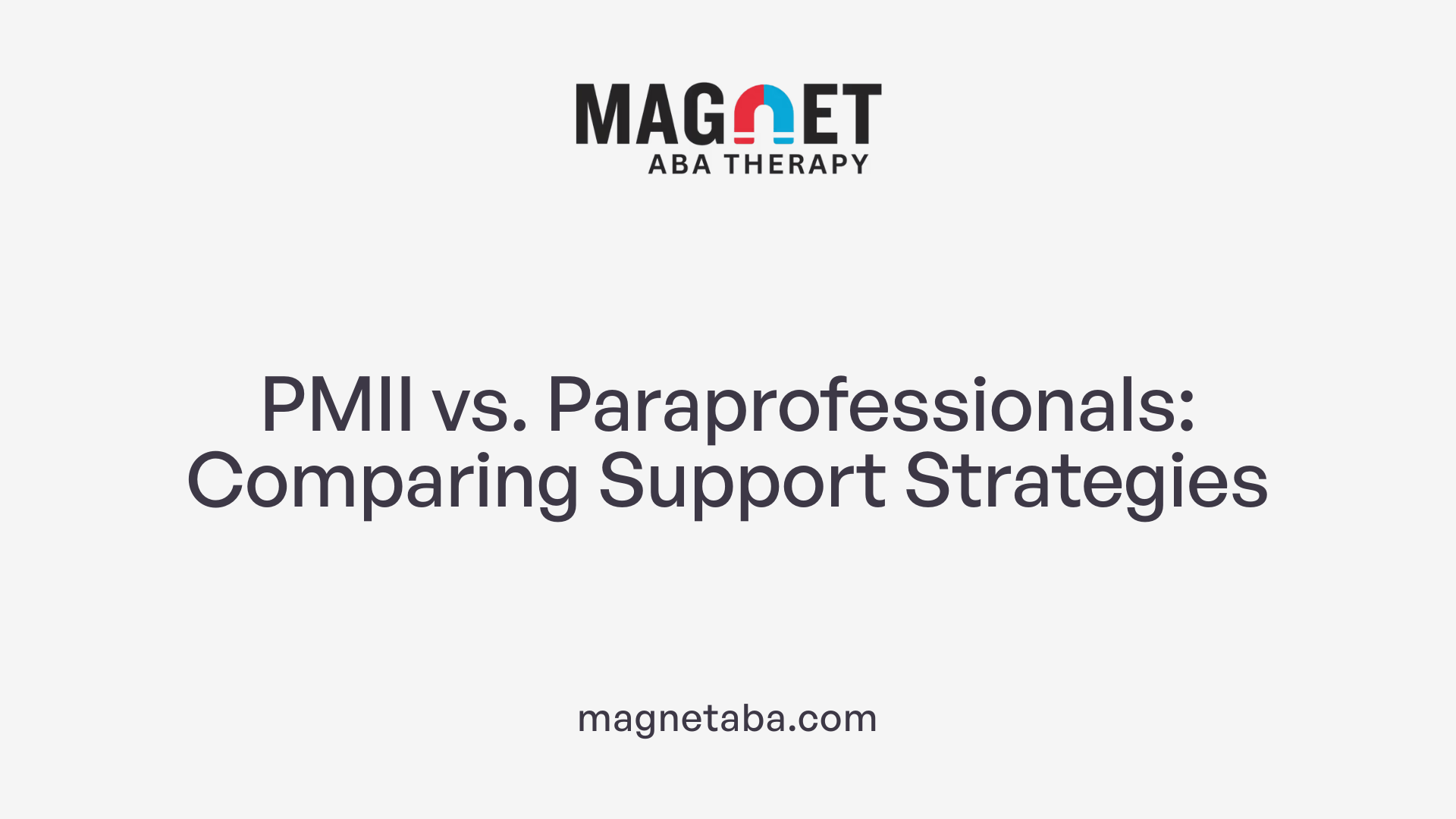
How Does PMII Compare to One-on-One Paraprofessional Approaches?
Peer-Mediated Instruction and Intervention (PMII) and one-on-one paraprofessional guidance are two strategies used to support children with autism spectrum disorder (ASD) in developing social skills. Unlike paraprofessional guidance, which involves individualized support from a specialist, PMII engages typically developing peers to facilitate social learning through natural interactions.
This peer-driven model encourages children with ASD to respond, initiate sharing, and engage in social interactions more flexibly and naturally. The use of peers as social models harnesses social learning processes such as imitation and reinforcement, often resulting in more generalized social skill development compared to one-on-one adult-led intervention.
What Are the Advantages of Peer-Mediated Models?
Peer-mediated approaches offer several benefits. First, peers are relatable role models who demonstrate appropriate social behaviors in real-time, promoting authentic social motivation among children with ASD. The interaction is often more reciprocal and less directive than adult-led sessions, fostering spontaneity.
Second, PMII can reduce the stigma and isolation sometimes associated with individualized paraprofessional support, as the intervention occurs within typical peer groups. Third, selection and training of peers with strong social and academic skills can ensure effective engagement and fidelity of intervention.
Lastly, PMII supports skills generalization across contexts by embedding social learning into everyday activities, promoting sustained social growth.
What Is the Potential of PMII in Classroom Settings?
PMII is widely integrated into early childhood and elementary education. Its design allows incorporation into daily curricula, enhancing classroom participation, social skills, and academic engagement for children with ASD.
By embedding intervention in group activities and social games—like imitation or passing games—PMII creates multiple social learning opportunities naturally occurring within the school day. Compared to one-on-one paraprofessional support, PMII encourages inclusion and peer acceptance, potentially leading to better academic and social outcomes.
Educators and clinicians often view PMII as a beneficial approach that complements existing individualized supports, making it a promising strategy for fostering social and interpersonal skills within inclusive classroom environments.
The Role of Peers in PMII: Selection and Training
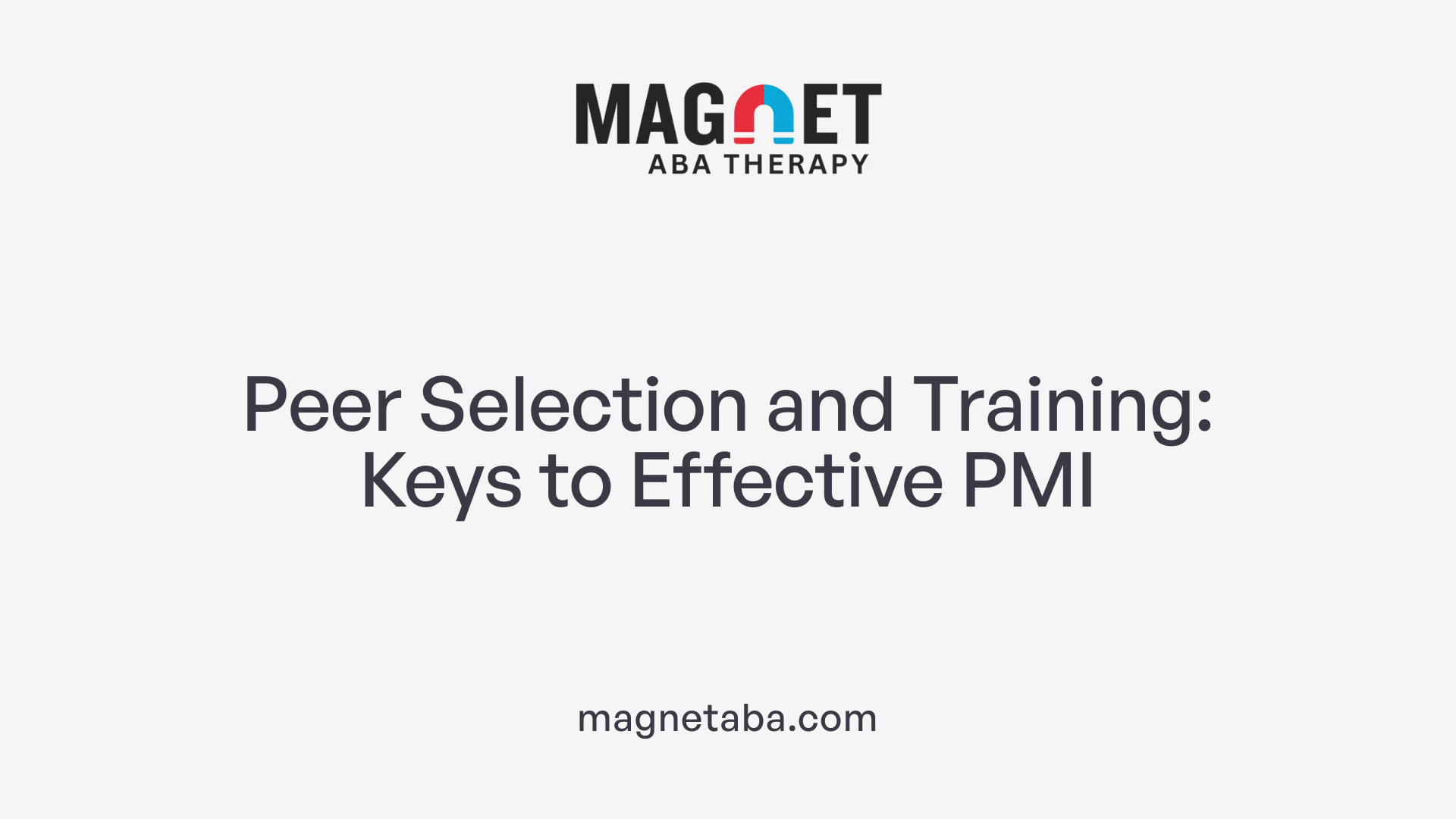
Criteria for Peer Selection
Peers chosen for Peer-Mediated Instruction and Intervention (PMII) are carefully selected to ensure they can effectively support children with ASD. These peers typically possess strong social skills and academic competencies, making them suitable role models and interaction partners. Such selection aims to optimize engagement and social learning opportunities for children with ASD.
Academic and Social Competencies Needed
Selected peers generally demonstrate solid academic performance, which supports their credibility within classroom environments. Equally important are their interpersonal abilities, including empathy, patience, and clear communication skills. These competencies enable them to facilitate social interaction naturally and encourage positive behaviors in children with ASD.
Training Processes to Engage Children with ASD
Peers receive structured training focused on intervention fidelity and social engagement techniques. Training includes practicing social games like imitation and rotating passing games designed to promote communication, imitation, and initiation of social interactions. This prepares peers to model appropriate behaviors, reinforce positive responses, and effectively involve children with ASD in social settings.
Peer Roles in Social Interaction Facilitation
Once trained, peers act as social facilitators by modeling socially acceptable behaviors and prompting interactions. Their roles include encouraging responding, sharing, turn-taking, and cooperative play. By integrating these actions into daily classroom activities, peers help enhance social motivation, reduce undesirable behaviors, and improve social skills in children with ASD, complementing traditional instruction methods.
Integrating PMI into Daily Curricula to Enhance Classroom Participation
How is Peer-Mediated Intervention (PMI) integrated into classroom settings?
Peer-Mediated Intervention (PMI) is effectively integrated into classroom settings primarily through the careful selection and training of typically developing peers. These peers, chosen for their strong social and academic skills, are taught specific strategies to engage children with autism spectrum disorder (ASD) in social interactions. PMI is embedded into the daily curricula, allowing social learning opportunities to occur naturally during routine classroom activities.
This approach moves beyond one-on-one paraprofessional guidance, encouraging naturalistic peer interactions throughout the school day. The intervention includes social games and structured activities designed to inspire communication, imitation, and social initiation, which seamlessly fit into academic and social components of daily lessons.
How does PMI promote social and academic engagement?
PMI promotes social engagement by increasing children's opportunities to interact with their peers in meaningful and supportive ways. The involvement of well-trained classmates fosters a positive social environment that motivates children with ASD to participate more actively in social exchanges and classroom dynamics.
Academically, promoting social interaction through PMI enhances classroom participation. As social skills improve, children with ASD become more confident and capable of engaging in collaborative learning and other academic tasks. This natural boost in communication and socialization directly correlates with better academic engagement.
In what ways does PMI enhance personal-social development?
PMI supports personal-social development by fostering essential skills such as sharing, responding to others, and understanding social cues. The peer interaction model provides constant social reinforcement and models appropriate behaviors in an accessible and relatable manner.
Through structured peer interactions and social games, children with ASD learn to adapt their behaviors and improve social motivation, while reducing undesirable behaviors. Over time, this nurtures greater self-confidence and improved ability to navigate social contexts both within and beyond the classroom.
What is the role of PMI in early childhood and elementary education contexts?
In early childhood and elementary education settings, PMI is widely used as a proven strategy to promote academic, interpersonal, and personal-social growth. Its integration within these early learning environments provides timely support during critical developmental stages.
By embedding PMI into everyday educational activities, young children with ASD receive ongoing practice with social skills development alongside typical academic instruction. This continual support helps them build foundational social competencies vital for lifelong success.
| Aspect | Implementation Details | Educational Impact |
|---|---|---|
| Peer Selection | Careful choice of socially and academically skilled peers | Facilitates positive and effective social engagement |
| Curriculum Integration | Embedded in daily classroom routines | Encourages naturalistic social learning and participation |
| Social Games | Includes imitation and passing games | Promotes communication, social initiation, and interaction |
| Academic Engagement | Enhanced through improved social skills | Increased confidence and participation in collaborative tasks |
| Personal-Social Development | Development of sharing, response, and understanding | Builds self-confidence and adaptive social behavior |
| Educational Settings | Applied in early childhood and elementary education | Provides early intervention aligned with developmental needs |
Pmii to Support Adaptive Behavior and Social Skills Development
How Does PMII Promote Adaptive Behavior Improvements?
Peer-mediated instruction and intervention (PMII) supports adaptive behavior by promoting socially acceptable actions within everyday environments. Unlike one-on-one paraprofessional guidance, PMII encourages children with ASD to learn through natural peer interactions, modeling, and reinforcement. This social learning fosters practical skills such as responding appropriately to others and sharing, which are essential components of adaptive behavior.
What Are the Interpersonal Skill Benefits?
PMII emphasizes social interaction by involving typically developing peers trained to engage children with ASD. Through activities like imitation games and rotating passing games, children enhance their social motivation and improve communication. Studies show that after PMII, children display increased social initiation, better social responsiveness, and reduced undesirable behaviors, particularly those with mild to moderate ASD symptoms.
How Does PMII Support Personal-Social Development?
In early childhood and elementary education, PMII aids personal-social skill growth by integrating peer-led social learning into daily curricula. Peers selected for their strong social and academic skills model positive social behaviors, helping children with autism develop interpersonal understanding and social engagement. The approach helps children grasp social cues and participate more fully in classroom and social settings.
What Makes PMII Widely Applicable in Early Education?
PMII's structure allows it to be used beyond clinical or specialist contexts, fitting seamlessly into school routines. Training peers and experimenters thoroughly ensures fidelity of intervention and maximizes social skill development in natural settings. Its adaptability makes PMII an effective, scalable option to support academic, interpersonal, and personal-social development across diverse educational environments.
| Aspect | Description | Impact on Children with ASD |
|---|---|---|
| Adaptive Behavior | Learning socially acceptable actions via peer reinforcement | Improved practical skills and behavior regulation |
| Interpersonal Skills | Peer-led social games and interaction | Increased social motivation and communication |
| Personal-Social Development | Integration into daily curricula | Enhanced classroom participation and social engagement |
| Educational Applicability | Suitable for early childhood and elementary education settings | Scalable support promoting comprehensive development |
Challenges and Considerations When Implementing PMI
What Are the Potential Limitations of PMI?
Peer-mediated intervention (PMI) shows promise in improving social skills among children with autism spectrum disorder (ASD), but several limitations must be considered. PMI tends to be more effective for children with mild to moderate ASD symptoms, suggesting limited benefits for those with severe symptoms. Additionally, while PMI can enhance social motivation and reduce undesirable behaviors, it may not address all core ASD challenges such as receptive language, adaptive behavior, or cognitive skills.
Why Is Appropriate Peer Training Essential?
Effective PMI depends heavily on the training and selection of peers. Peers must possess strong social and academic skills and receive thorough training to engage children with ASD appropriately. This ensures high fidelity of intervention and maximizes social skill development. Without adequate training, peers may struggle to model, reinforce, or encourage social behaviors correctly, reducing PMI's effectiveness.
How Does Variability in ASD Symptoms Affect PMI?
ASD is highly heterogeneous, resulting in a wide spectrum of symptom severity and behavioral challenges. PMI tends to yield stronger outcomes in children with less severe symptoms, especially in social communication domains. However, children with more profound impairments often require individualized or additional one-on-one interventions. This variability necessitates careful participant selection and customization within PMI programs.
What Are Setting-Specific Factors Impacting PMI?
The setting where PMI is delivered influences its success. While many programs occur in inclusive or classroom environments, hospital-rehabilitation settings also provide structured opportunities for social skill development. Each setting demands adaptations in intervention delivery, peer recruitment, and activity design. Factors such as availability of trained staff, peer group dynamics, and access to appropriate social games like imitation or passing games impact outcomes.
Considering these challenges highlights the importance of tailored, well-supported PMI programs with appropriate peer preparation and awareness of individual child needs and the intervention environment. Addressing these factors can help maximize the benefits of PMI for children with ASD.
Synergies Between PMI and Traditional ABA Approaches
How Does PMI Complement Traditional ABA Techniques?
Peer-Mediated Intervention (PMI) enriches traditional Applied Behavior Analysis (ABA) methods by harnessing the natural social environment of children with ASD. While ABA often focuses on structured one-on-one interventions to teach targeted behaviors and skills, PMI incorporates typically developing peers as social models and reinforcement agents. This approach promotes social learning through imitation, modeling, and reinforcement, which are essential components in ABA but are delivered in a more dynamic and interactive setting in PMI.
What Are the Combined Effects on Socialization and Communication?
The integration of PMI with traditional ABA therapies has demonstrated enhanced outcomes in socialization and communication. Research, including randomized controlled trials, showed that children with ASD engaging in PMI experienced greater improvements in overall social skills and social communication compared to those receiving only traditional ABA methods. Improvements include increased social motivation, enhanced social interaction, and a reduction in undesirable behaviors, particularly among children with mild to moderate ASD symptoms. Structured social games such as imitation and rotating passing games facilitate these gains by encouraging communication initiation and reciprocal interactions.
How Can Therapeutic Outcomes Be Enhanced Through Peer Involvement?
Involving peers in therapy maximizes the generalization of learned skills to real-world settings. PMI's peer trainers are carefully selected for strong social and academic abilities and undergo thorough preparation to maintain intervention fidelity. Their involvement ensures continuous and natural reinforcement of social behaviors beyond clinical environments. Additionally, delivering PMI in hospital-rehabilitation settings offers a controlled atmosphere while fostering natural, peer-driven social exchanges. Combined with traditional ABA’s individualized focus on communication and daily living skills, this synergy enhances intellectual functioning and social competence in children with ASD.
| Aspect | Traditional ABA | Peer-Mediated Intervention (PMI) | Combined Approach Benefits |
|---|---|---|---|
| Intervention Delivery | One-on-one, therapist-led | Peer-led, naturalistic social interactions | Enhanced social motivation and real-world practice |
| Focus Areas | Communication, behavior, daily living | Social skills, social initiation, peer interaction | Broader social and communicative competence |
| Settings | Clinical, home, educational | Hospital-rehabilitation, classroom | Greater generalization across environments |
| Skill Reinforcement | Structured reinforcement systems | Peer modeling and reinforcement | Increased spontaneous social communication |
| Target Populations | Children with varying ASD severity | Especially mild to moderate ASD | More tailored and effective intervention outcomes |
Long-Term Benefits of Incorporating PMI within ABA Programs
How Does PMI Support Sustained Social Skills Improvements?
Peer-mediated intervention (PMI) enhances social skills in children with Autism Spectrum Disorder (ASD) by engaging typically developing peers to initiate and maintain social interactions. Long-term, children participating in PMI demonstrate increased social motivation and improved social communication. The social games and interactions embedded in PMI promote ongoing practice, helping these skills become more stable and lasting beyond the intervention period.
Can Learned Behaviors Generalize Beyond Intervention Settings?
One major advantage of PMI within ABA is the generalization of social behaviors. Because PMI involves peers in naturalistic settings such as classrooms or recreational environments, children with ASD can apply learned social skills across multiple contexts. This contrasts with one-on-one interventions, which may limit practice to highly structured environments. PMI's use of imitation and social initiation games encourages spontaneous and flexible social engagement.
What is the Potential Impact on Adaptive Functioning?
While traditional ABA focuses heavily on communication and socialization, integrating PMI may also influence adaptive functioning by improving peer relationships and social participation. These gains can translate to enhanced daily living skills and better integration into academic and community settings. Although current meta-analyses report limited evidence on adaptive behavior improvement from ABA alone, combining PMI with ABA shows promise for such wider functional benefits.
What Does Research Say About Long-Term Outcomes?
Although long-term outcome studies are relatively limited, randomized controlled trials demonstrate that PMI results in meaningful social gains sustained over time, especially in children with mild to moderate ASD symptoms. The thorough training of peers and structured social activities ensure fidelity and effectiveness. Emerging evidence suggests that ABA programs incorporating PMI may yield superior social functioning and communication outcomes over conventional interventions. Continued research is needed to evaluate comprehensive impacts on cognition and adaptive behavior.
Overall, integrating PMI into ABA interventions offers a promising avenue for sustaining social improvements, encouraging generalization of skills, and supporting adaptive functioning in children with ASD over the long term.
Future Directions for ABA and Peer-Mediated Interventions

What are the emerging research trends in ABA and peer-mediated interventions?
Research continues to evolve in Applied Behavior Analysis (ABA) and peer-mediated interventions (PMI), with a growing focus on improving socialization and communication outcomes for children with autism spectrum disorder (ASD). Recent meta-analyses highlight promising effects, yet indicate the need for more rigorous trials to explore impacts on broader developmental domains like adaptive behavior and cognition. Emerging trends include greater attention to individualized interventions that reflect the specific social and communication needs of each child.
How is technology being integrated into ABA and peer-mediated interventions?
Technological advancements are increasingly integrated into ABA and PMI, offering innovative tools to enhance intervention delivery. For example, digital platforms and apps facilitate peer training and fidelity monitoring, while virtual reality environments provide safe, controlled settings for practicing social skills. Such technologies support data collection in real time and assist therapists and peers in adapting strategies according to individual progress, potentially improving engagement and outcomes.
In what diverse settings are these interventions expanding?
ABA and peer-mediated approaches are expanding beyond traditional clinical or school environments into hospital-rehabilitation centers, community programs, and even home-based settings. This broadening scope allows access to early intervention for children with varying ASD severity levels. The involvement of trained peers in inclusive settings promotes naturalistic social learning, fostering better generalization of skills across multiple environments.
What is the potential for tailoring interventions further?
Personalization of ABA and PMI strategies is a key future direction. By carefully selecting and training peers based on social and academic strengths, and customizing social games and interaction techniques, interventions become more responsive to individual profiles. This tailored approach can maximize the development of social motivation, expressive communication, and adaptive daily living skills. Combining this with data-driven feedback and technology ensures interventions remain dynamic and child-centered.
Overall, these advancements aim to enhance both the reach and efficacy of ABA and peer-mediated interventions, ensuring children with ASD receive comprehensive support that addresses their unique behavioral and social challenges in engaging, real-world contexts.
Empowering Families and Educators through PMI and ABA
How are caregivers and teachers trained in PMI and ABA?
Training in Peer-Mediated Intervention (PMI) and Applied Behavior Analysis (ABA) is essential to ensure intervention fidelity and maximize benefits for children with ASD. Caregivers and teachers receive thorough instruction on the specific techniques used in these approaches, including social games like imitation and rotating passing that foster communication and social initiation. Through structured training sessions, they learn to model appropriate social behaviors, reinforce positive interactions, and effectively engage children during therapy sessions.
How is ongoing social development supported for children with ASD?
Supporting ongoing social development involves integrating PMI and ABA strategies across settings and daily routines. With guidance, families and educators embed social learning opportunities into classroom or home activities, promoting consistent practice. Peer partners trained through PMI encourage social initiation and interaction beyond therapy sessions, which increases social motivation and helps reduce undesirable behaviors. This continuous support nurtures skills such as sharing, responding to others, and communication, fostering generalization across environments.
What collaborative approaches enhance intervention delivery?
Collaboration between families, educators, therapists, and peers lies at the heart of effective intervention delivery. Communication between caregivers and school staff ensures that intervention goals align with the child's needs and daily schedules. Peers selected for their social and academic strengths are trained to engage children with ASD, creating natural opportunities for social learning. Additionally, hospital or rehabilitation settings that provide such interventions emphasize team coordination to adapt techniques and maintain consistency. This collaborative model empowers all stakeholders to contribute meaningfully to a child's social and academic growth.
Conclusion: Expanding the Horizons of Autism Therapy with Peer-Mediated Interventions
What are the benefits of peer-mediated interventions (PMI) within the ABA framework?
Peer-mediated interventions (PMI) incorporate typically developing peers to engage children with autism spectrum disorder (ASD) in social interactions. When combined with Applied Behavior Analysis (ABA), PMI offers distinct advantages. It notably increases social motivation, fosters enhanced social interaction, and reduces undesirable behaviors, especially for children with mild to moderate ASD symptoms. Through structured games focused on imitation and social initiation, children learn to communicate and respond more effectively.
How promising is PMI for enhancing social skills in children with ASD?
The evidence from a well-conducted randomized controlled trial shows that PMI leads to significant improvements in overall social skills and social communication beyond those achieved by traditional ABA approaches. Using reliable instruments like the Social Responsiveness Scale (SRS) and the Child Autism Rating Scale (CARS), studies confirm these social benefits. This suggests that PMI can be a powerful strategy to support children in overcoming core social challenges associated with ASD.
Why is an individualized, evidence-based approach important in ASD interventions?
ABA and ABA-based models including PMI emphasize tailored, scientific methods that focus on environmental variables impacting behavior. This allows for interventions crafted to the unique profile of each child, promoting more effective skill acquisition in communication, socialization, daily living, and self-help. Such individualized treatment maximizes developmental gains and supports long-term improvements in language and social functioning.
What is the vision for broader adoption and future research of PMI in autism therapy?
Given the promising outcomes demonstrated in hospital-rehabilitation settings, PMI shows considerable potential for wider application across various educational and therapeutic environments. Its integration into daily curricula and classroom dynamics can foster academic, interpersonal, and social growth for children with ASD. Continued research should focus on expanding samples, refining methodologies, and exploring long-term effects to establish more comprehensive guidelines. Broad adoption of PMI within ABA can thus extend support to more children, enhancing their social engagement and quality of life.
Evolving Autism Care Through Collaborative Peer-Based Approaches
Peer-mediated interventions represent a dynamic and promising component in the evolution of Applied Behavior Analysis therapy for children with autism spectrum disorder. By harnessing the influence of typically developing peers trained to facilitate social engagement, PMI enriches the therapeutic landscape beyond traditional methods, particularly enhancing social motivation, communication, and interaction. With rigorous training, validated assessment, and careful implementation, this approach complements ABA’s foundational techniques and offers a path to more naturalistic, generalized, and enduring skill development. As research progresses and integration expands, PMI holds strong potential to empower individuals with autism, educators, and families alike, contributing to more inclusive and effective developmental support.
References
- Efficacy of Interventions Based on Applied Behavior ...
- Effectiveness of peer-mediated intervention on social skills for ...
- What is Peer-Mediated Instruction and Intervention?
- Applied Behavior Analysis (ABA)
- Applied Behavior Analysis (ABA)
- Applied Behavior Analysis
- Applied Behavior Analysis (ABA)
- Board Certified Behavior Analysts (BCBA)












